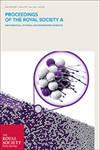延时Wilson-Cowan振子环中的分岔和同步
IF 3
3区 综合性期刊
Q1 MULTIDISCIPLINARY SCIENCES
Proceedings of the Royal Society A: Mathematical, Physical and Engineering Sciences
Pub Date : 2023-10-01
DOI:10.1098/rspa.2023.0313
引用次数: 0
摘要
环结构在网络神经科学中至关重要,可以通过反馈系统中的闭环电路集成神经信息。在这里,我们使用数值分岔分析来探讨延迟耦合威尔逊-考恩质量环上的时间延迟效应。通过研究上述系统的低维“自耦合”版本,我们揭示了同步流形的分岔结构,并揭示了由于Hopf分支交叉和随后的高阶分岔而出现的各种动态同步模式。对整个系统的分析表明,在参数空间的大区域内,同步状态下存在横向不稳定性,环形网络结构根据耦合强度和延迟时间之间的平衡促进了各种动态。在弱耦合下,涌现振荡通常是同步或反相位同步的,它们之间的过渡由周期轨道的环面分岔触发。同步解和反相同步解的区域由环面击穿引起的弱混沌边界划分。随着耦合强度的增加,分支图呈现出更多重叠的分支结构,导致动力学日益复杂、多稳定。本文章由计算机程序翻译,如有差异,请以英文原文为准。
Bifurcations and synchrony in a ring of delayed Wilson–Cowan oscillators
Ring structures are crucial in network neuroscience, enabling the integration of neural information through closed loop circuits within feedback systems. Here, we use numerical bifurcation analysis to explore time delay effects on a ring of delay-coupled Wilson–Cowan masses. Investigating a low-dimensional ‘self-coupled’ version of the aforementioned system, we uncover the bifurcation structure of the synchronization manifold, and unveil a diverse array of dynamic synchronization patterns that emerge as a consequence of Hopf branch crossings and subsequent higher-order bifurcations. Analysis of the full system reveals transverse instabilities in the synchronized state for large regions of parameter space, with the ring network architecture promoting various dynamics depending on the balance between coupling strength and delay time. Under weak coupling, emergent oscillations are generally synchronous or anti-phase synchronous, with transitions between them triggered by a torus bifurcation of a periodic orbit. Regions of synchronous and anti-phase synchronous solutions are delineated by weakly chaotic borders due to the breakdown of the torus. As coupling strength increases, the bifurcation diagram displays more overlapped branching structure, resulting in increasingly complicated, multistable dynamics.
求助全文
通过发布文献求助,成功后即可免费获取论文全文。
去求助
来源期刊
CiteScore
6.40
自引率
5.70%
发文量
227
审稿时长
3.0 months
期刊介绍:
Proceedings A has an illustrious history of publishing pioneering and influential research articles across the entire range of the physical and mathematical sciences. These have included Maxwell"s electromagnetic theory, the Braggs" first account of X-ray crystallography, Dirac"s relativistic theory of the electron, and Watson and Crick"s detailed description of the structure of DNA.

 求助内容:
求助内容: 应助结果提醒方式:
应助结果提醒方式:


